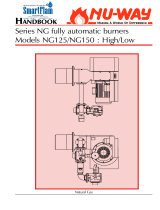
Table of Contents
1.0 INTRODUCTION ................................................................................................................................................................................................... 4
2.0 PRINCIPAL PARTS ............................................................................................................................................................................................... 5
3.0 TECHNICAL DATA ................................................................................................................................................................................................ 9
4.0 GENERAL REQUIREMENTS ............................................................................................................................................................................. 11
4.1 RELATED DOCUMENTS ............................................................................................................................................................................. 11
5.0 WATER QUALITY ............................................................................................................................................................................................... 12
6.0 LOCATION ........................................................................................................................................................................................................... 12
6.1 PLANT ROOM REQUIREMENTS ................................................................................................................................................................ 12
6.2 GENERAL REQUIREMENTS ....................................................................................................................................................................... 12
6.3 CLEARANCES .............................................................................................................................................................................................. 13
6.4 CONDENSATE DRAIN ................................................................................................................................................................................. 13
7.0 GAS SUPPLY ...................................................................................................................................................................................................... 13
7.1 SERVICE PIPES ........................................................................................................................................................................................... 13
7.2 METERS ....................................................................................................................................................................................................... 13
7.3 GAS SUPPLY PIPES .................................................................................................................................................................................... 13
7.4 BOOSTED SUPPLIES .................................................................................................................................................................................. 13
7.5 PLANT-ROOM CONTROL VALVE ............................................................................................................................................................... 13
7.6 EQUIPMENT GAS SYSTEM LEAK CHECK ................................................................................................................................................ 14
8.0 FLUE SYSTEM .................................................................................................................................................................................................... 14
8.1 FLUE SYSTEM GENERAL REQUIREMENTS............................................................................................................................................. 15
8.2 APPROVED FLUE SYSTEM ........................................................................................................................................................................ 15
8.3 INSTALLATION PRECAUTIONS ................................................................................................................................................................. 15
8.4 MAXIMUM LENGTH ..................................................................................................................................................................................... 15
8.5 FLUE DISCHARGE ....................................................................................................................................................................................... 15
8.6 CONDENSATE DRAIN ................................................................................................................................................................................. 15
8.7 WATER HEATER CONNECTION ASSEMBLY ........................................................................................................................................... 16
8.7.1 EKW45CE – EKW60CE ......................................................................................................................................................................... 16
8.7.2 EKW85CE – EKW145CE ....................................................................................................................................................................... 18
8.7.3 EKW175CE ............................................................................................................................................................................................ 19
8.7.4 EKW205CE – EKW235CE ..................................................................................................................................................................... 20
8.8 FLUE TERMINAL INSTALLATION ............................................................................................................................................................... 21
8.8.1 TYPE B
23
................................................................................................................................................................................................ 21
8.8.2 TYPE C
13
................................................................................................................................................................................................ 21
8.8.3 TYPE C
33
................................................................................................................................................................................................ 22
8.8.4 TYPE C
43
................................................................................................................................................................................................ 23
8.8.5 TYPE C
53
................................................................................................................................................................................................ 23
8.9 FLUE TERMINAL GUARDING ..................................................................................................................................................................... 23
9.0 AIR SUPPLY ........................................................................................................................................................................................................ 24
9.1 COMBUSTION VENTILATION ..................................................................................................................................................................... 24
9.2 COOLING VENTILATION ............................................................................................................................................................................. 24
10.0 WATER CONNECTIONS .................................................................................................................................................................................... 25
10.1 GENERAL ..................................................................................................................................................................................................... 25
10.2 OPEN VENTED SYSTEM ARRANGEMENT ............................................................................................................................................... 25
10.3 UNVENTED SYSTEM ARRANGEMENT ..................................................................................................................................................... 25
10.3.1 EXPANSION VESSEL SIZING ........................................................................................................................................................ 26
10.4 DE-STRATIFICATION .................................................................................................................................................................................. 26
10.5 CIRCULATING PUMPS ................................................................................................................................................................................ 26
10.6 FLOW TEMPERATURE SENSOR ............................................................................................................................................................... 27
10.6.1 DRY-POCKET SENSOR ................................................................................................................................................................. 27
10.6.2 STRAP-ON SENSOR ...................................................................................................................................................................... 27
10.6.3 SENSOR WIRING ........................................................................................................................................................................... 27
11.0 ELECTRICAL SUPPLY ....................................................................................................................................................................................... 28
11.1 EXTERNAL CONTROLS .............................................................................................................................................................................. 28
11.1.1 REMOTE ENABLING ...................................................................................................................................................................... 28
11.2 HIGH VOLTAGE CONNECTOR STRIP ....................................................................................................................................................... 29
11.3 LOW VOLTAGE CONNECTOR STRIP ........................................................................................................................................................ 29
11.4 ELECTRICAL CONNECTIONS .................................................................................................................................................................... 31
11.5 FUSES .......................................................................................................................................................................................................... 31
11.6 ARC WELDING PRECAUTIONS.................................................................................................................................................................. 31
11.7 WIRING DIAGRAM ....................................................................................................................................................................................... 32
11.8 LADDER DIAGRAM ...................................................................................................................................................................................... 33
12.0 SMART SYSTEM CONTROL .............................................................................................................................................................................. 34
12.1 GENERAL ..................................................................................................................................................................................................... 34
12.2 SMART SYSTEM CONTROL PANEL .......................................................................................................................................................... 34
12.3 SEQUENCE OF OPERATION ...................................................................................................................................................................... 35
12.4 STATUS DISPLAY SCREENS ..................................................................................................................................................................... 36
13.0 COMMISSIONING AND TESTING ..................................................................................................................................................................... 38
13.1 ELECTRICAL INSTALLATION ..................................................................................................................................................................... 38
13.2 GAS INSTALLATION .................................................................................................................................................................................... 38
13.3 WATER CONNECTIONS.............................................................................................................................................................................. 38
13.4 COMMISSIONING THE EQUIPMENT ......................................................................................................................................................... 38
13.4.1 GENERAL CHECKS PRIOR TO LIGHTING ................................................................................................................................... 38
13.4.2 EQUIPMENT CHECKS PRIOR TO LIGHTING............................................................................................................................... 38
13.4.3 PROCEDURE FOR INITIAL LIGHTING .......................................................................................................................................... 39
13.4.4 GAS PRESSURE ADJUSTMENT AND COMBUSTION CHECKS ................................................................................................ 39
























